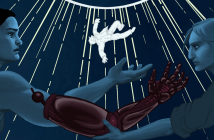When I was in high school, my friends and I would often hang around outside in the Blockbuster parking lot. In the cold New England winters, we would sit in the car and talk; in the summer we would walk to get ice cream and then stand around—loitering as a past time.
I visit my hometown as much as I can, and I can still get ice cream at the same store, although the blockbuster storefront is now vacant. If I close my eyes I can almost see the vision of me and my friends, laughing outside, listening to music, falling in love for the first time.
Adolescence is a time of great change, as for many of us, we are leaving or preparing to leave our families, friends, and homes for perhaps the first time, and set out as individuals. For some of us this may mean coming back an entirely different person, unrecognizable to even ourselves. How can we know that we left an impression, that we made a difference, that we mattered, when even the very places that we would hang out are changed, or do not exist anymore? (RIP Blockbuster.)
I think that’s why young adults need ghost stories more than other age groups, because when everything around you is changing so rapidly, and you feel things so intensely, it feels like it should leave a mark. You can get a scar on your hand from a hot cookie sheet, or from knee surgery after a sports injury and these marks remain for years or perhaps a lifetime. The emotional trials of high school and first loves and deep intense friendships can also affect you for a lifetime, but there’s no tangible evidence of them at all.
This has intensified for teens today. I have notes that were passed in class, and developed photographs that were taken on disposable cameras to catalogue my time, to show as evidence that these things did really happen. Today, with SnapChat and Instagram Stories designed to be ephemeral, the relics and artifacts are disappearing. The only signs are our own memories, our own ghosts. Unfortunately, as with all ghosts, memories are notoriously unreliable.
There are two types of YA ghost stories—horror and non-spooky. There are some very exciting scary YA ghost stories out right now that perfectly capture the intensity of the teenage experience, such as The Dark Beneath the Ice by Amelinda Berube or Anna Dressed in Blood by Kendare Blake. There are also more lighthearted takes on ghost stories such as the Shadowland series by Meg Cabot. Whether sunny and fun, or make you want to hide under the covers scary, there are a lot of ghosts in the YA world.
In The Last Ghost, the ghosts of a boy who died team up with his Death to try to solve the mysteries surrounding his demise. Although he died after college graduation, the novel highlights the ghost of who he was when he was sixteen years old, because it is the strongest ghost. In The Last Ghost, ghosts are not the spirit of a person who died who had unfinished business. Instead, they are an encapsulation of the moment when a human heart is broken. Because even the happiest adolescents have some heartbreak, there are a lot of teenage ghosts.
I wrote The Last Ghost when I was dealing with a few tragic losses of my own, and I wanted to write the book that would have provided me some comfort during a difficult time. I hope it is able to provide the same to any readers that need it. Whether they are choosing spooky or sweet, teens need ghost stories because the ghosts are evidence that they were here, and they matter.

